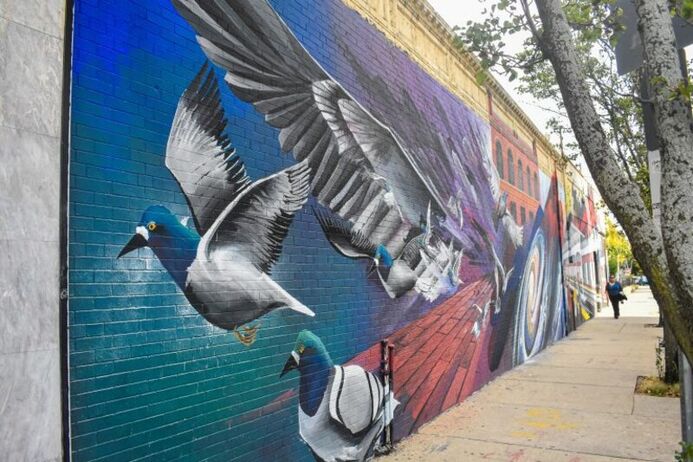Felipe Ortiz is the artist behind one of #CentralSQ’s newest murals! His piece titled “Past, Present, Future” spans along Norfolk St. and incorporates a plethora of quintessential pieces of #CentralSQ culture and history.

I was born and raised in Cali, Colombia, and was often encouraged to be around the arts. In 1999, I moved to the United States with my family and ended up settling in Massachusetts, where I attended MassArt.
From perspective drawings to geometric patterns to urban realism, I combine techniques and create unique art pieces. In 2016, I organized the “Fresco Exchange” for artists in Latin America and the US, resulting in exhibitions, urban art projects, and community engagement. Through this self-funded project, we have successfully exhibited over 60 artists at an international level and organized public art tours throughout the U.S.

The concept for this mural was based on the theme of “Past, Present, Future.” Having spent much of my student life in Central Square, the invitation to do this mural created a full circle for me. Central Square has been a place where many key moments in my life have taken place. This process became a very collaborative one, as I improvised most of the composition based on people’s comments and reactions. Some of the influence came from the previous wave of murals created in Central Square in the 90s, especially the “Potluck.”
I wanted to depict pigeons as part of the concept of this design. I have a certain respect for city birds, pigeons in particular. As one of the toughest urban species, pigeons represent resilience, amongst many other things, depending on perspective. Pigeons are a species found throughout the majority of the world, and this is an interesting comparison associated with how many people from different parts of the world can be found in Cambridge.

The Dance Complex building is incorporated in my mural as a staple of community and diversity, and it was a frequent request from people passing by. I also painted a representation of a galaxy to embody our existence. The train station is a representational approach to depict Central Square and its people. The idea is to have an anamorphic effect — viewing the train’s direction change as the viewer walks across the mural.
I was first invited to participate in Central Square’s mural project in November of last year. It was very challenging to complete the whole mural with bucket paint (as I am a brush painter). More challenges came with the weather not cooperating, and a portion of my mural was washed off during a 3-day rain pour. This past summer, I returned to the US eager to finish the mural. The improvisational aspect of this piece led me to add a lot more than I had initially intended to paint. This is a street-level mural, so a lot of people interacted as they walked by, creating a sense of community which I really enjoyed.

I incorporated myself by allowing others to guide my decision for composition. I knew I had an idea of what I wanted to paint based on past personal experiences, but in order to represent the proposed theme of “Past, Present, Future,” I wanted the input of local residents. Most of the people who first noticed I was starting to paint a mural were elders who had been in Central Square for years. I thought their voices could be interpreted by my art.
Even though I have specific meanings intended for this mural, at the end of the day, it is open for interpretation, and I love that everyone can have their own opinion. 99% of responses have been positive so I wanted that positivity to remain a factor in this instance. I hope for people to see all the “hidden” things, like the two-point perspective and the anamorphic effect as you walk by, but this piece is truly for the people.
As far as the artwork is concerned, I enjoy all of it, and as a cultural hub, Central Square is one of my favorite urban places in Massachusetts. I particularly enjoy David Fichter’s work because of how many people feel represented by it. I also enjoy the new trajectory of contemporary artists who participated in this recent project, as well as those who are attracted by the public Graffiti Alley.

This mural project showcases and promotes the new active muralists in the area. It also adds to an existing number of public artworks in the city and by doing this, it increases the cultural value in the area, making this area stand out. Even if you don’t know much about art, the fact that it is accessible for everyone is a win for the city, its residents, and its visitors. This project creates a sense of pride in its residents and it is the locals who define this city with their history, their knowledge, and their experiences. Art has the ability to touch on all these aspects and what better way than to find self-pride through public art.
I am grateful for this opportunity and I am forever thankful for all the love I received from the people of Cambridge, project organizers, and enthusiasts who have believed and supported my work. I see a lot more people use places like Graffiti Alley and I hope that through this project, we can adopt more public legal walls so that everyone can have an opportunity to paint. Thank you.
To see more of Felipe’s work, follow him on Instagram @felipeortizart or head to his website felipeortiz.com
